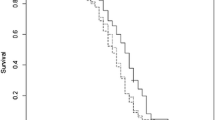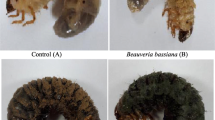Abstract
Pathogenicity and thermal biology (tb) were investigated for entomopahogenic fungi isolates (EFI), which were examined as potential biocontrol agents of the ectoparasite Varroa destructor, the major disease of honey bees in Andalusia (Spain). All 16 of the assayed EFI were pathogenic to V. destructor, while two of them were exceptionally pathogenic to the mite: Metarhizium anisopliae 01/121-Su [AST 35.0 h, 100% mortality at 72 h post infection (p.i.)] and Beauveria bassiana 01/103-Su (AST 39.4 h, 96.0% mortality at 72 h p.i.). The tb of the five most virulent isolates against the mite was investigated at seven temperatures (10–40 °C) by using a modified generalized beta function that accounted for 79.8–96.4% of the data variance. Optimum temperatures and maximum temperatures for growth ranged from 24.9 to 31.2 °C and from 30.1 to 35.0 °C respectively. On the basis of their pathogenicity, thermal requirements and safety to honey bees, two isolates showed promise as candidates for V. destructor control.
Zusammenfassung
Ziel der Untersuchung war, die Pathogenität und Thermobiologie von insektenpathogenen Pilzen als potentielle mikrobische Behandlungsmittel gegen den Ektoparasiten Varroa destructor, den schädlichsten Parasiten der Honigbienen (Apis mellifera iberiensis) in Andalusien (Spanien) zu ermitteln. Darüber hinaus selektierten wir Isolate mit begrenzter Wirkung gegen adulte Honigbienen und deren Puppen. Wir untersuchten 16 Pilzisolate aus den vier Arten B. bassiana [7 Isolate, von denen zwei aus am Boden von Versuchsbienenvölkern in Granada und Jerez (Spain) gefundenen V. destructor Milben stammten], M. anisopliae (fünf Isolate), L. lecanii (ein Isolat) und Hirsutella sp. (drei Isolate). Die meisten der 16 Isolate entstammten der Sammlung autochthoner Kulturen des C.R.A.F. Department der Universität von Cordoba.
In dem Pathogenitätstest ließen wir adulte, aus einem befallenen Volk gesammelte weibliche V. destructor Milben jeweils 5 Minuten lang über die 16 Pilzisolate laufen. Diese wurden dann paarweise in Eppendorfröhrchen verbracht, die eine weißäugigen Puppe enthielten. Die Röhrchen wurden bei 27 °C und 70 % RH inkubiert. Alle der untersuchten Pilzarten waren pathogen für die Milben, hierbei waren die Isolate von B. bassiana und M. anisopliae am virulentesten. Von den 16 untersuchten Isolaten hoben sich zwei auf Grund ihrer Pathogenität ab: M. anisopliae EAMa 01/121-Su Isolat (AST 35,0 h, 100 % Mortalität 72 h nach Infektion) und B. bassiana EABb 01/103-Su Isolat (AST 39,4 h, 96,0 % Mortalität 72 h nach Infektion). Generell wiesen Puppen, die während des Tests starben, nach einer 7 Tage dauernden Inkubierung in einer feuchten Kammer keine durch die insektenpathogenen Pilze hervorgerufenen Mykosen auf, keines der vier untersuchten Isolate war für adulte Bienen pathogen.
Die thermische Biologie der fünf Isolate mit höchter Pathogenität für V. destructor wurden bei sieben verschiedenen Temperaturen untersucht (10– 40 °C). Die radiale Wachstumsrate der Kolonien wurde aus der Steigung der linearen Regression über die Zeit abgeschätzt, und die Daten wurden dann an eine modifizierte generalisierte Betafunktion angepasst, durch die 79,8–96,4 % der Datenvarianz erfasst wurde. Die für die Ausbreitungsrate optimalen Temperaturen lagen zwischen 24,9 bis 31,2 °C, während die Maximaltemperaturen für das Pilzwachstum von 3,1 bis 35,0 °C variierten.
Auf Grund ihrer Pathogenität und ihrer Temperaturbedürfnisse, zusammen mit dem Fehlen einer Pathogenität für Honigbienen erwiesen sich zwei der Isolate als viel versprechende Kandidaten für die Bekämpfung von V. destructor in mediterranen Honigbienenvölkern. Auf Basis dieser Ergebnisse planen wir die Untersuchung von experimentellen Formulierungen dieser zwei Isolate in Freilandversuchen zur Bekämpfung der Varroose in Spanien. Wir beabsichtigen weiterhin die thermische Biologie der beiden aus V. destructor gewonnen B. bassiana Isolate, insbesondere Isolat EABb 07/05-Su, zu untersuchen, mit dem Ziel diese in unsere Freilanduntersuchungen einzubeziehen.
Similar content being viewed by others
References
Anon P. (2001) Resistant Varroa mites found in bee hives in the UK, Bee Craft 83, 6–8.
Barnett L., Hunter B.B. (1987) Illustrated Genera of Imperfect Fungi, 4th ed., MacMillan Publishing, New York, 218 p.
Bassanezi R.B., Amorim L., Bergamin Filho A., Hau B. (1998) Effects of bean line pattern mosaic virus on the monocyclic components of rust and angular leaf spot of Phaseolus bean at different temperatures, Plant Pathol. 47, 289–298.
Bates D.M., Watts D.G. (1988) Nonlinear regression and its applications, New York, Wiley.
Campbell C.L., Madden L.V. (1990) Introduction to plant disease epidemiology, John Wiley & Sons Inc., New York, USA.
Chandler D., Suderland K.D., Ball B.V., Davison G. (2001) Prospective biological control agents of Varroa destructor n. sp., an important pest of European honey bee, Apis mellifera, Biocontrol Sci. Technol. 11, 429–448.
Davidson G., Phelps K., Sunderland K.D., Pell J.K., Ball B.V., Shaw K.E., Chandler D. (2003) Study of temperature-growth interactions of entomopathogenic fungi with potential for control of Varroa destructor (Acari: Mesostigmata) using a nonlinear model of poikilotherm development, J. Appl. Microbiol. 94, 816–825.
Fargues J., Maniania N.K., Delmas J.C., Smits N. (1992) Influence de la temperature sur la croissance in vitro d’hyphomycetes entomopathogénes, Agronomie 12, 557–564.
García Fernández P., Benítez Rodríguez R., Orantes Bermejo F.J. (1995) Influence du climat sur le développement de la population de Varroa jacobsoni Oud. dans des colonies d’Apis mellifera iberica (Goetze) dans le sud de l’Espagne, Apidologie 26, 371–380.
García Fernández P., Martínez Moya J.L., Luzón Ortega J. (2001) Encuesta epidemiológica sobre patología apícola (1; 2), Vida Apíc. 106, 17–20; 107, 45–49.
Goettel M.S., Inglis G.D. (1997) Fungi: Hyphomycetes, in: Lacey L.A. (Ed.), Manual of techniques in insect pathology, Academic, San Diego, CA, pp. 213–248.
Humber R.A. (1997) Fungi: identification, in: Lacey L.A. (Ed.), Manual of Techniques in Insect Pathology, Academic Press, San Diego, pp. 153–185.
Kanga L.H.B., James R.R. (2002) Varroa control with fungal pathogens may be an option soon, Am. Bee J. 142, 519.
Kanga L.H.B., James R.R., Boucias D.G. (2002) Hirsutella thompsonii and Metarhizium anisopliae as potential microbial control agents of Varroa destructor, A honey bee parasite, J. Invertebr. Pathol. 81, 175–184.
Kanga L.H.B., Jones W.A., James R.R. (2003) Field Trials Using the Fungal Pathogen, Metarhizium anisopliae (Deuteromycetes: Hyphomycetes) to Control the Ectoparasitic Mite, Varroa destructor (Acari: Varroidae) in Honey Bee, Apis mellifera (Hymenoptera: Apidae) Colonies, J. Econ. Entomol. 96, 1091–1099.
Le Conte Y., Arnold G., Desenfant P.H. (1990) Influence of brood temperature and hygrometry variations on the development of the honey bee ectoparasite Varroa jacobsoni (Mesostigmata: Varroidae), Environ. Entomol. 19, 1780–1785.
Luzón J.M., García-Fernández P. (2002) Assay to detect τ-fluvalinate resistant Varroa destructor in Spain, Rev. Ibér Parasitol. 62, 64–68.
Meikle W.G., Mercadier G., Girod V., Derouané F., Jones W.A. (2006) Evaluation of Beauveria bassiana (Balsamo) Vuillemin (Deuteromycota: Hyphomycetes) strains isolates from varroa mites in southern France, J. Apic. Res. 45, 219–220.
Meikle W.G., Mercadier G., Holst N., Nansen C., Girod V. (2007) Duration and spread of an entomopathogenic fungus Beauveria bassiana (Deuteromycota): Hyphomycetes) used to treat Varroa mites (Acari: Varroidae) in honey bee (Hymenoptera: Apidae) hives, J. Econ. Entomol. 100, 1–10.
Milani N. (1999) The resistance of Varroa jacobsoni Oud. to acaricides, Apidologie 30, 229–234.
Ouedraogo A., Fargues J., Goettel M.S., Lomer C.J. (1997) Effect of temperature on vegetative growth among isolates of Metarhizium anisopliae and M. flavoviride, Mycopathologia 137, 37–43.
Peng C.Y.S., Zhou X., Kaya H.K. (2002) Virulence and site of infection of fungus, Hirsutella thompsonii to the honey bee ectoparasitic mite, Varroa destructor, J. Invertebr. Pathol. 81, 185–195.
Quesada-Moraga E., Maranhao E.A.A., Valverde-García P., Santiago-Álvarez C. (2006) Selection of Beauveria bassiana isolates for control of the whiteflies Bemisia tabaci and Trialeurodes vaporariorum on the basis of their virulence, thermal requirements and toxicogenic activity, Biol. Control 36, 274–287.
Quesada-Moraga E., Navas-Cortés J.A., Maranhao E.A., Ortiz-Urquiza A., Santiago-Álvarez C. (2007) Factors affecting the occurrence and distribution of entomopathogenic fungi in natural and agricultural soils, Mycol. Res. 111, 947–966.
Schoolfield R.M., Sharpe P.J.H., Magnuson C.E. (1981) Non linear regression of biological temperature-dependent rate models based on absolute reaction-rate theory, J. Theor. Biol. 88, 719–731.
Shaw K.E., Davidson G., Clark S.J., Ball B.V., Pell J.K., Chandler D., Suderland K.D. (2002) Laboratory bioassays to assess the pathogenicity of mitosporic fungi to Varroa destructor (Acari: Mesostigmata), an ectoparasitic mite of the honey bee, Apis mellifera, Biol. Control 24, 266–276.
Simpson J. (1961) Nest climate regulation in honey bee colonies, Science 133, 1327–1333.
Southwick E.E., Heldmaier G. (1987) Temperature control in honey bee colonies, Bioscience 37, 395–399.
SPSS (1997) SPSS 8.0 for Windows, SPSS Inc. Headquarters, 233 S. Wacker Drive, 11th floor, Chicago, IL, 60606, USA.
Todd J.H., De Miranda J.R., Ball B.V. (2007) Incidence and molecular characterization of viruses found in dying New Zealand honey bee (Apis mellifera) colonies infested with Varroa destructor, Apidologie 38, 354–367.
Wallner K. (1999) Varroacides and their residues in bee products, Apidologie 30, 235–248.
Yeo H., Pell J.K., Alderson P.G., Clark S.J., Pye B.J. (2003) Laboratory evaluation of temperature effects on the germination and growth of entomopathogenic fungi and on their pathogenicity to two aphid species, Pest Manage. Sci. 59, 156–165.
Zimmermann G. (2007a) Review on safety of the entomopathogenic fungi Beauveria bassiana and Beauveria brongniartii, Biocontrol Sci. Technol. 17, 553–596.
Zimmermann G. (2007b) Review on safety of the entomopathogenic fungus Metarhizium anisopliae, Biocontrol Sci. Technol. 17, 553–596.
Author information
Authors and Affiliations
Corresponding author
Additional information
Manuscript editor: Marla Spivak
Rights and permissions
About this article
Cite this article
García-Fernández, P., Santiago-Álvarez, C. & Quesada-Moraga, E. Pathogenicity and thermal biology of mitosporic fungi as potential microbial control agents of Varroa destructor (Acari: Mesostigmata), an ectoparasitic mite of honey bee, Apis mellifera (Hymenoptera: Apidae). Apidologie 39, 662–673 (2008). https://doi.org/10.1051/apido:2008049
Received:
Revised:
Accepted:
Issue Date:
DOI: https://doi.org/10.1051/apido:2008049
- Varroa destructor
- Apis mellifera
- entomopathogenic fungi
- virulence
- biological control
- Beauveria
- Metarhizium
- Lecanicillium
- Hirsutella
- mite
- parasites
- mycoacaricides




